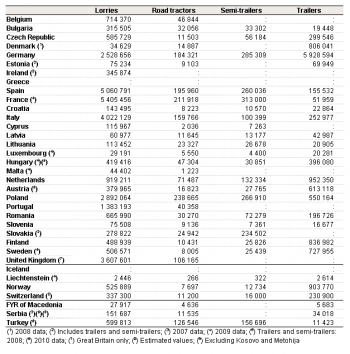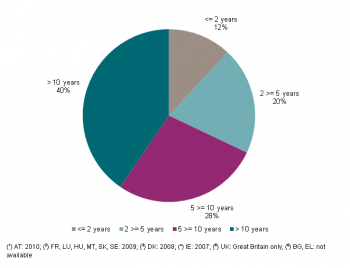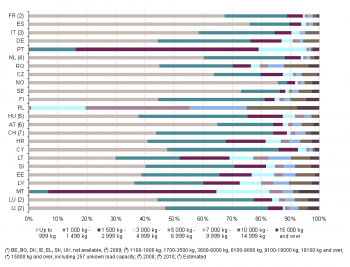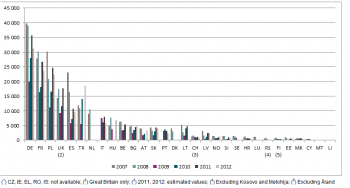Archive:Road freight vehicle statistics - lorries, road tractors and trailers
- Data from December 2013. Most recent data: Further Eurostat information, Main tables and Database.
This article presents statistics on vehicles for transport of freight in the European Union (EU): lorries, road tractors, semi-trailers and trailers. It describes the development in the number of such vehicles and analyses the trends in the registration of new vehicles. It also analyses the load capacity of these vehicles, which is crucial for the capacity of the transport sector in the EU to move freight.

Source: Eurostat (online data code: (road_eqs_lrstn)

Source: Eurostat (online data code: (road_eqs_lorroa)

Source: Eurostat (online data code: (road_eqs_lornum)

Source: Eurostat (online data code: (road_eqs_lorton)

Source: Eurostat (online data code: (road_eqs_lormot)

Source: Eurostat (online data code: (road_eqr_lorrin)

Source: Eurostat (online data code: (road_eqr_lrstn)
Main statistical findings
High number of lorries in France and Spain; France recorded the most new lorries
Amongst the EU Member States, the highest number of lorries was found in France (5.4 million lorries; 2009 data) and Spain (5.1 million), followed by Italy (4.0 million), the United Kingdom (3.6 million; Great Britain only) and Poland (2.9 million) (see Table 1).
Analysing the data behind Figure 1, the highest number of 2 years old or newer lorries was found in France, with 864 873 lorries. There were high numbers of such new lorries also in the United Kingdom (514 355), Germany (491 196) and Spain (400 278). However, the age structure of the national stocks of lorries differs greatly between Member States. In many eastern and southern Member States the main share of the lorries were 10 years old or older. The highest shares of old lorries in the total were found in Malta, representing 85 % of all registered lorries in the country. Thereafter followed Poland and Slovakia; in both countries, 69 % of the lorries were more than 10 years old. In contrast, Ireland had the lowest share of old lorries, making up only 13 % of the registered lorries; correspondingly the share of ’new’ lorries, i.e. lorries that were two years old or younger, was 24 %. Amongst the EU Member States, only Denmark (29 %), Austria and Sweden (both 25 %) had higher shares of new lorries than Ireland.
Road tractors are motor vehicles designed to haul semi-trailers or other not motorised vehicles. In 2011, the largest stock of road tractors amongst was found in Poland (238 665 road tractors). Correspondingly, Poland also had the third highest number of semi-trailers (266 910) amongst the Member States. Other countries with high numbers of road tractors and semi-trailers are France (211 918 road tractors and 313 000 semi-trailers; 2009 data), Spain (195 960 road tractors and 260 036 semi-trailers) and Germany (184 321 road tractors and 285 309 semi-trailers).
Spain have the most small lorries
In 2011, Spain had the highest number amongst the Member States of small lorries with a load capacity of less than one tonne. These 3.8 million small lorries made up 76 % of the lorries in Spain; among the other Member States, these smallest lorries made up a similarly large share of the registered lorries in Sweden (73 %). Small lorries also made up around two thirds of the total number of lorries in France, Austria and the Czech Republic.
As can be seen from Figure 2, the two categories covering lorries with capacity of up to one tonne and of between one and one and a half tonnes respectively, made up between 75 % and 90 % of the total number of lorries in more than half of the countries available. Notable exceptions were Portugal and Malta, where the combination of the two capacity classes from 1.5 up to 3 tonnes and from 3 up to 5 tonnes made up 79 % and 76 % of the registered lorries respectively. In Poland, the two categories from 5 up to 7 tonnes and from 7 up to 10 tonnes made up 56 % of the total, with the smallest capacity categories having just a marginal importance. However, in this context, it should be reminded that the methodologies for the voluntary Common Questionnaire for Inland Transport are not harmonised; differences may to a certain extent reflect national vehicle registration systems and practices. See the section below on Data sources and availability for more details.
Table 2 shows that the actual load capacity of registered lorries are relatively evenly distributed over the different size classes (in terms of load capacity) in the Member States for which data are available. The smallest lorries (up to 1.5 tonnes load capacity) generally provides around 30 % of the total load capacity of the registered lorries, the medium size categories (from 1.5 up to 10 tonnes) also provide around 30 % and the largest lorries (10 tonnes or more load capacity) provide around 40 % of the load capacity. The smallest lorries provides around half of the total lorry load capacity in Spain (51 %), Cyprus (49 %) and the Netherlands (48 %). In contrast, the largest lorries provided half or more of the total lorry load capacity in Finland (56 %), Sweden (52 %) and Luxembourg (49 %). However, it should be noted that these data are only available for 15 Member States.
Table 3 shows that lorries with a load capacity of 1.5 tonnes or more are almost exclusively fuelled by diesel; with the exception of Malta (2.3 %), less than 1 % of these lorries are powered by petrol. Similarly, with the exception of Luxembourg (2.0 %) and Sweden (1.5 %), less than 1 % of these larger lorries are powered by alternative fuels.
Also for the smaller lorries with a load capacity of less than 1.5 tonnes is diesel the most common fuel. However, in most Member States the share of small lorries powered by petrol lies between 2 % and 9 %. The main exceptions are Malta and Estonia, where 35 % and 20 % respectively of these smaller lorries are powered by petrol. Alternative fuels play only a marginal role also for the smaller lorries; their share is below 1 % for most Member States for which data are available. However, in Italy 5.3 % of small lorries were powered by alternative fuels, including hybrid motor concepts. Sweden and Poland also stand out with alternative fuels shares of 2.7 % and 1.7 % respectively.
Data sources and availability
Data source
The Eurostat/ITF/UNECE Common Questionnaire on Inland Transport.
Definitions
All definitions used are taken from the Eurostat/UNECE/ITF Illustrated Glossary for Transport Statistics, currently in its 4th edition. This glossary can be found on Eurostat’s website.
- Road vehicle designed, exclusively or primarily, to carry goods. Included are:
- Light goods road vehicles with a gross vehicle weight of not more than 3 500 kg, designed exclusively or primarily, to carry goods, e.g. vans and pick-ups
- Heavy goods road vehicles with a gross vehicle weight above 3 500 kg, designed, exclusively or primarily, to carry goods
- Road tractors
- Agricultural tractors permitted to use roads open to public traffic.
- Goods road motor vehicle
- Any single road motor vehicle designed to carry goods (e.g. a lorry), or any coupled combination of road vehicles designed to carry goods, (i.e. lorry with trailer(s), or road tractor with semi-trailer and with or without trailer).
- Lorry / truck
- Rigid road motor vehicle designed, exclusively or primarily, to carry goods.
- Road tractor
- Road motor vehicle designed, exclusively or primarily, to haul other road vehicles which are not power-driven (mainly semi-trailers). (Agricultural tractors are excluded.)
- Trailer
- Goods road vehicle designed to be hauled by a road motor vehicle (excludes agricultural trailers and caravans.)
- Semi-trailer
- Goods road vehicle with no front axle designed in such way that part of the vehicle and a substantial part of its loaded weight rests on a road tractor.
- Road train
- Goods road motor vehicle coupled to a trailer. Articulated vehicle (road tractor coupled to a semi-trailer) with a further trailer attached is included.
- Load capacity
- Maximum weight of goods declared permissible by the competent authority of the country of registration of the vehicle.
- Gross vehicle weight (Legally permissible maximum weight)
- Total of the weight of the vehicle (or combination of vehicles) including its load when stationary and ready for the road declared permissible by the competent authority of the country of registration. This includes the weight of the driver and the maximum number of persons permitted to be carried.
- Unladen vehicle weight
- Weight of vehicle (or combination of vehicles) excluding its load when stationary and ready for the road. The unladen weight may include driver and fuel, dependent on national practice.
- Cylinder capacity
- The cylinder capacity of the engine as certified by the competent authority of the country of registration.
- Motor energy
- The principal type of motor energy used by the vehicle as certified by the competent authority of the country of registration. For hybrid or dual-fuelled vehicles adapted for using more than one type of motor energy (e.g. LPG and petrol, or electricity and diesel, etc.), the principal type of motor energy should be, where possible, an alternative fuel.
- Alternative fuel
- A type of motor energy other than the conventional fuels petrol and diesel. Alternative fuels include electricity, LPG, natural gas (NGL or CNG), alcohols, mixtures of alcohols with other fuels, hydrogen, biofuels (such as biodiesel), etc. (This list is not exhaustive.) Alternative fuels do not include unleaded petrol, reformulated petrol or city (low-sulphur) diesel.
Context
The Common Questionnaire on Inland Transport is a joint project of Eurostat, the International Transport Forum (ITF) and the United Nations Economic Commission for Europe (UNECE). The data are provided on a voluntary basis by a large number of countries, both within and outside the European Union. Data is collected from reliable sources, but data collection methodologies are not harmonised at EU level. Comparability across countries is restricted as the classifications used in the national vehicle registers are not harmonised. Vehicles registers may exclude taxis, pick-up and vans, and may also exclude very old vehicles. This article covers data provided by the EU Member States, the European Free Trade Association (EFTA) countries and EU enlargement countries.
See also
- Transport introduced
- Road freight transport statistics
- Road freight transport by vehicle characteristics
- Stock of vehicles at regional level
- Manufacture of motor vehicles, trailers and semi-trailers statistics - NACE Rev. 2
- Motor trades statistics - NACE Rev. 2
- Sustainable development - transport
Further Eurostat information
Data visualisation
- Regional Statistics Illustrated - select statistical domain 'Transport' (top right)
Publications
- Energy, transport and environment indicators - Pocketbook - 2013 edition
- Europe in figures - Eurostat yearbook 2013, chapter 10: Transport
- Decline in European road freight transport in 2011 reflecting the economic climate - Statistics in focus 38/2012
- Slow recovery in road freight transport in 2010 - Statistics in focus 15/2012
- Six years of road freight growth lost to the crisis - Statistics in focus 12/2011
Main tables
- Transport statistics, see:
- Road transport (t_road)
Database
- Transport statistics, see:
- Road transport (road)
- Road transport equipment - Stock of vehicles (road_eqs)
- Road transport equipment - New registration of vehicles (road_eqr)
Dedicated section
Methodology / Metadata
- Vehicle stocks: road_eqs_esms
- New vehicles: road_eqr_esms
- Eurostat/UNECE/ITF Illustrated Glossary for Transport Statistics, 4th edition
Source data for tables, figures and maps (MS Excel)
Other information
- White paper COM(2011) 144 final Roadmap to a single European transport area – towards a competitive and resource efficient transport system
- Handbook on statistics on road traffic - Methodology and experience (UNECE, 2007)
External links
- International Transport Forum (ITF) - Statistics
- United Nations Economic Commission for Europe (UNECE) - Transport statistics
Notes
[[Category:<Infrastructure and means>|Road freight vehicle statistics - lorries, road tractors and trailers]] [[Category:<Road>|Road freight vehicle statistics - lorries, road tractors and trailers]]
[[Category:<Statistical_article>|Road freight vehicle statistics - lorries, road tractors and trailers]]
[[Category:<Transport>|Road freight vehicle statistics - lorries, road tractors and trailers]]